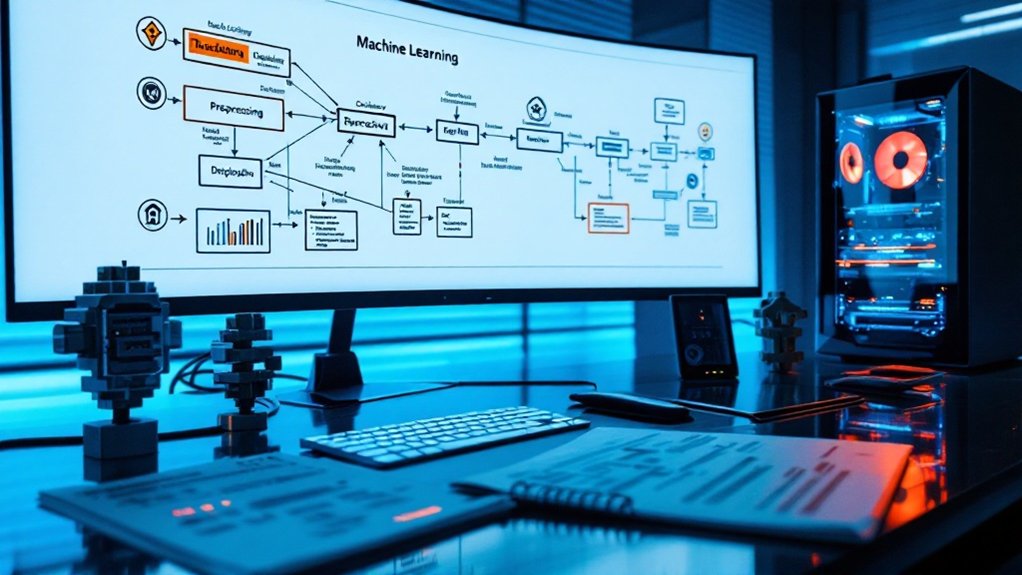Building a machine learning model involves five key steps. First, define the problem and business objectives clearly. Next, collect and prepare data, removing outliers and splitting into training sets. Then select an appropriate model based on the problem type and train it. Evaluate performance using validation techniques and tune hyperparameters. Finally, deploy the model with proper version control and monitoring. The journey from concept to production isn't simple, but the results are worth it.

Launching on a machine learning project isn't for the faint of heart. It demands precision, patience, and a methodical approach that starts with clearly defining the problem. Practitioners must pinpoint business objectives, determine what type of learning task they're tackling—classification, regression, whatever—and take stock of available resources. It's essential to identify the expected outputs of your model to ensure alignment with business goals.
Success metrics need establishing upfront. And let's not forget the ethical implications. Because algorithms with bias? Not a good look. Modern AI agents can help validate and test for potential biases during development.
Define your metrics before the first line of code. Biased algorithms aren't just bad science—they're bad business.
Data collection comes next. Getting the right datasets. Cleaning them. It's tedious work, honestly. Missing values and outliers need addressing before any serious analysis begins.
Exploratory data analysis reveals patterns and relationships—crucial insights that guide feature engineering. The data split is non-negotiable: training, validation, test sets. Done.
Choosing the right model isn't rocket science, but it's close. The algorithm must match the problem type. There's always the trade-off between complexity and interpretability. Some fancy models require serious computational muscle. Your chosen framework should support RESTful architecture for smooth integration with other systems.
Research what others have used for similar problems. No need to reinvent the wheel.
Training happens next. Initialize the architecture, set the hyperparameters, implement the loop. Watch those metrics like a hawk.
Overfitting is the enemy. Apply regularization techniques. Simple stuff, really. Except when it's not.
Evaluation is where dreams die or flourish. The validation set tells the truth. Cross-validation adds robustness. Hyperparameter tuning is tedious but necessary. Grid search, random search—pick your poison.
Analyze errors. Rinse, repeat.
Testing on the held-out data reveals the cold, hard reality. Compare against baselines. Statistical significance matters. Understand limitations through error analysis. Check for fairness issues.
Deployment is the final frontier. The model needs preparing for production. Version control is non-negotiable. Monitoring for data drift keeps things honest. Schedule retraining. Plan updates. Consider creating an API with FastAPI and uvicorn to make your model accessible as a prediction service that stakeholders can easily utilize.
And there you have it. Building a machine learning model. Complex, yes. Impossible, no.
Frequently Asked Questions
How Much Does It Cost to Build a Machine Learning Model?
Building machine learning models isn't cheap. Basic projects start around $10,000, while advanced solutions can exceed $1.2 million. No joke.
Data preparation eats 60-80% of the budget—that's where the money goes. Mid-level AI apps typically cost $25,000-$120,000. Ongoing maintenance? Another 25-75% on top.
Companies can save by using pre-trained models or open-source tools. The complexity determines everything. Simple models, smaller wallets.
Can Machine Learning Models Work Without Internet Connection?
Yes, machine learning models can absolutely work offline. They're called offline models, duh.
Trained on existing datasets, these models run locally without needing to phone home. Great for privacy and speed. No waiting for server responses.
Perfect for autonomous vehicles, mobile apps, and IoT devices in the middle of nowhere.
The trade-off? Models can get stale without updates. But hey, that's the price of independence.
How Often Should Machine Learning Models Be Retrained?
Machine learning models need retraining at wildly different frequencies. It depends.
Manufacturing models? Maybe yearly. Consumer behavior? Weekly or monthly. Fraud detection demands daily updates—criminals don't take vacations.
The deciding factors? Data drift, performance degradation, and new data availability. Some models trigger retraining when accuracy drops below thresholds. Others when enough fresh data arrives.
No one-size-fits-all here. Monitor continuously, people.
What Programming Languages Are Best for Machine Learning Beginners?
Python dominates the ML beginner scene. No contest. Its readable syntax makes learning curves less steep, and those libraries? NumPy, Pandas, TensorFlow—they're game-changers.
R works too, especially for stats nerds. Julia's gaining steam but isn't quite beginner-friendly yet. JavaScript? Fine if you're already a web dev.
But honestly, Python's massive community means help is always available when (not if) you get stuck.
How Do I Protect Intellectual Property in My Machine Learning Model?
Protecting ML intellectual property requires a multi-layered approach.
Patents work for novel architectures but not abstract algorithms.
Copyright covers source code automatically.
Trade secrets are effective for keeping training methods confidential—just don't leak them.
Contractual protection through licensing agreements restricts usage and redistribution.
No single method's perfect. Smart developers use combinations, implementing technical measures like API keys while maintaining strict access controls.
The real challenge? Enforcement.




